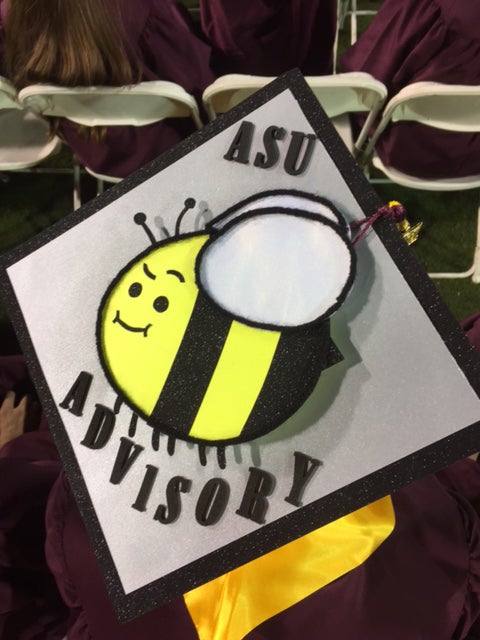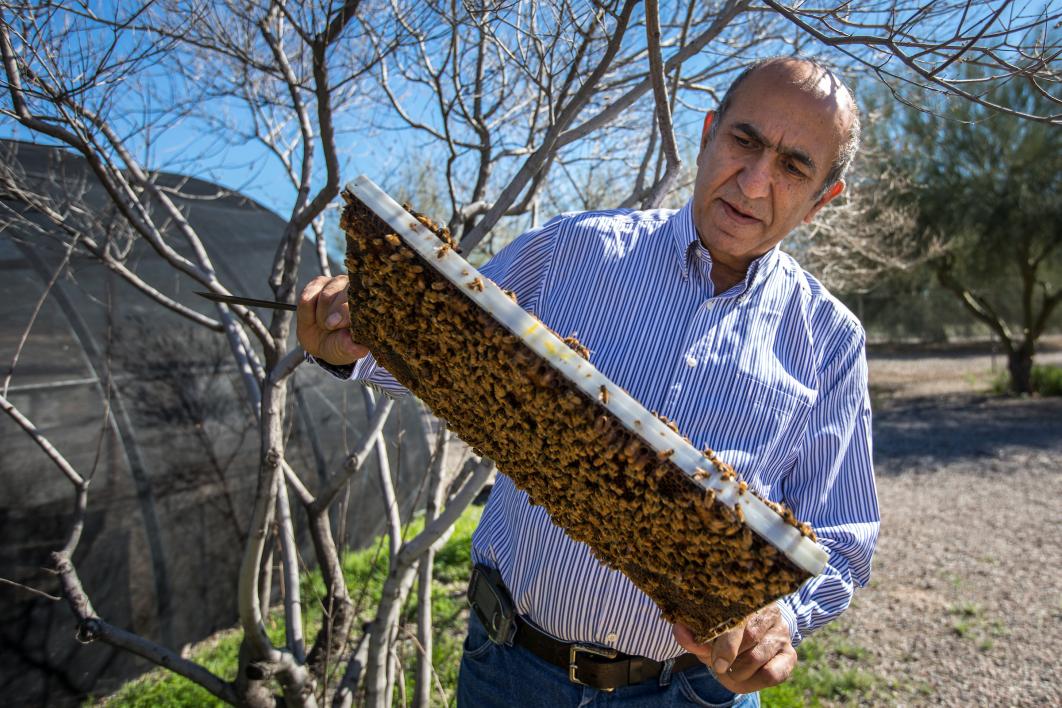Bees. Again.
When they’re buzzing at Arizona State University’s four Phoenix-area campuses, your phone buzzes too. Even if you’re in another state or abroad, you’ll get the advisories if you’re entered into the university’s directory.
“ASU Advisory — A message from ARIZONA STATE UNIVERSITY ASU Advisory-Polytechnic: Swarm of bees reported near Peralta stairwell. Please use caution in the area.”
The inevitable collision of bee advisories, the Internet and college humor has birthed ASU bee-focused social media pages: It’s been suggested that ASU should consider changing its mascot from Sparky the Sun Devil to a Swarm of Bees. It’s also been suggested that ASU change its name to BSU.
But are there really that many swarms? Has anyone been stung? And aren’t bees on the decline?
. . . .
ASU students have fun with the bee advisories, which help direct Sun Devils away from potentially dangerous swarms. Photo by Steve Des Georges/ASU
“If I get one more email about bees at ASU I'm going to hire a personal exterminator to follow me around,” one student posted to Facebook.
“Got stung by one of the ASU bees yesterday,” another Twitter user posted. “Now this ... is personal. Keep those text alerts coming, ASU Advisory.”
“It’s how you know spring has arrived at ASU,” a Reddit user pointed out on one of the dozens of ASU bee threads.
Finally, another tweeter said: “ASU might as well change the damn mascot to killer bees since they overrun EVERY SINGLE one of our CAMPUSES!”
. . . .
Well, not every campus. Thunderbird and West seem to bee free.
There have been no injuries from bees this year, ASU Police spokeswoman Katy Harris said. The department does not keep track of the number of bee advisories, but a review of their Twitter feed reveals there have been 13 this calendar year. (Before February the last advisory was in July 2016.) The Polytechnic campus had six, Tempe six, and Downtown Phoenix one.
That’s a normal year, said associate director of facilities management Ellen Newell.
“Our department just puts caution tape up around a swarm to keep people away and then removes the tape when they have moved on,” Newell said. “This is the busiest time of year for swarms, and we have had a lot, but really not more than normal. The swarms will usually move within 24 hours and most often quicker than that, so they are really only a slight inconvenience.
The real concern are aggressive hives that are in areas where people frequent or where the bees nest in building walls, and the honey starts causing problems.”
The university actually has a bee sightings Web page, most notable for its admonition to not aggravate the bees, even though they are aggravating you.
. . . .
Osman Kaftanoglu pulls up a hive while looking for the queen and talking about the bee life cycle at the Bee Lab at ASU's Polytechnic campus.
Managed honey bee populations are declining. There were 5.5 million colonies in the U.S. in the 1950s, down to about 2.5 million now, according to Osman Kaftanoglu, lab project manager at ASU’s Honey Bee Research Lab — the largest bee research program in North America, outside of the USDA Bee Lab.
Pesticides, habitat destruction, pollution, honey bee diseases, parasites and combinations of all those factors are wiping out bees, but ASU researchers are looking for solutions.
ASU School of Life Sciences Professor Gro Amdam, a biologist who studies behavior and aging in honey bees, is working toward creating bee vaccines.
Jon Harrison, an environmental physiologist who studies how insects function, interact with their environment and evolve, is partnering with other ASU scientists to study the effects two widely used fungicides have on bees. Research has shown that when bees are fed pollen containing these fungicides, they lose appetite and have difficulty digesting protein.
Robert Page, provost emeritus, foundation chair of life sciences at ASU and a prominent honey bee geneticist, has been studying and selecting bees that are superior pollinators. Page has found that some bees collect more pollen (a protein) and less nectar (a carbohydrate), and enjoy superior nutrition as a result. Selectively breeding this higher-protein-consuming population can lead to healthier bee colonies.
But if bee numbers are down, where are the swarms coming from?
Swarms come from Africanized feral colonies, Kaftanoglu said. Such bees were first introduced to Brazil in the 1950s. They arrived in North America in 1985 and have invaded all the Southern states.
“The number of Africanized colonies are increasing every year,” Kaftanoglu said. “Since they develop faster, swarm much more than the European colonies and are resistant to most bee diseases and parasites, they are expanding their territory and becoming more populous. That is why we are getting more swarm warnings and calls every year.”
. . . .
Bees might not overrun every campus, but at ASU they have a home — just stay away from it unless you're helping with research.
Top photo: Worker bees at ASU's Honeybee Research Lab on the Polytechnic campus. Photo by Charlie Leight/ASU Now
More Science and technology

ASU water polo player defends the goal — and our data
Marie Rudasics is the last line of defense.Six players advance across the pool with a single objective in mind: making sure that yellow hydrogrip ball finds its way into the net. Rudasics, goalkeeper…

Diagnosing data corruption
You are in your doctor’s office for your annual physical and you notice the change. This year, your doctor no longer has your health history in five-inch stack of paperwork fastened together with…
Large-scale study reveals true impact of ASU VR lab on science education
Students at Arizona State University love the Dreamscape Learn virtual reality biology experiences, and the intense engagement it creates is leading to higher grades and more persistence for biology…




